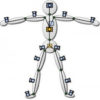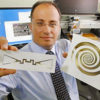Researchers at Georgia Tech have demonstrated how a smartphone accelerometer (the sensor that detects the phone’s orientation) can sense nearby computer keyboard vibrations and decipher complete sentences with up to 80 percent accuracy. Georgia Tech’s Patrick Traynor (pictured) is presenting his team’s work this week at the 18th ACM Conference on Computer and Communications Security […]










